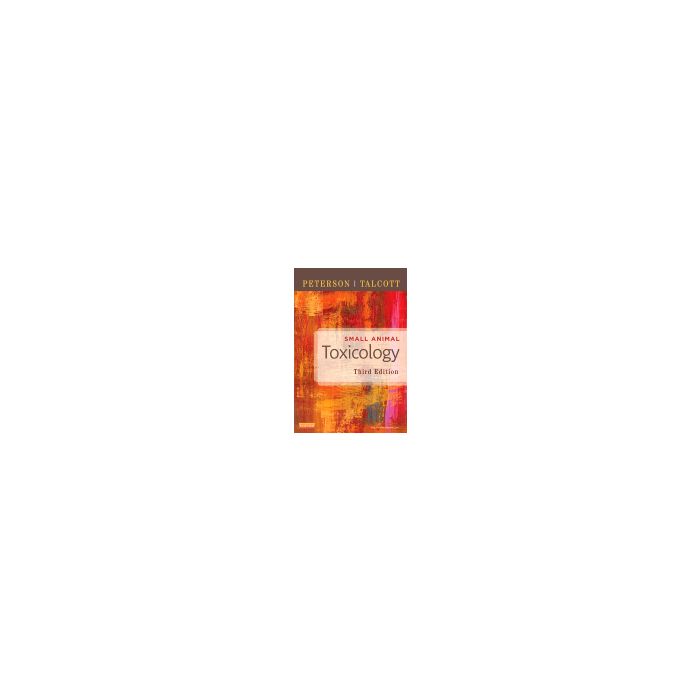Small Animal Toxicology, 3rd Edition [Peterson - Elsevier Science]

- ISBN/EAN
- 9781455707171
- Editore
- Elsevier Science
- Formato
- Brossura
- Anno
- 2012
- Edizione
- 3
- Pagine
- 1232
Disponibile
74,99 €
This revised and expanded reference is a valuable aid for the practicing veterinary clinician in diagnosing and determining treatment for toxic exposures in small animals, and for veterinary students as a supplement to their classroom instruction. It contains chapters addressings nontraditional areas of toxicology not covered in conventional toxicology texts. It also covers areas of toxicology which seem basic but are rarely discussed, such as taking a toxicological history, establishing a minimum database, providing supportive care, and managing emergency treatment of the poisoned patient. The book is organized into three sections, including 20 new chapters and new topics such as grapes and raisins, lilies, "Christmas time" plants, mercury, and accidental poisoning in non-traditional pets.
KEY FEATURES
New two-color design makes the book more esthetically pleasing and allows for quick retrieval of information
Toxic Plant Information Summary tables make treatments for plant intoxications easy to find
Toxic Plant Quick Reference Based on Clinical Signs tables are included, to support small-animal veterinarians in cases of potential toxic plant ingestion
Summary charts at the beginning of each chapter in the Specific Toxicants section contain bulleted lists with clear-cut information on the specific toxicant, the clinical signs, and prognosis
A comprehensive review of all known potentially toxic substances is provided, from A (acetaminophen) to Z (zinc), including the very latest on grape and raisin toxicity — making this the most up-to-date and thorough text in this field
45 different experts contribute to this book, all from the field of veterinary toxicology and medicine
Maggiori Informazioni
| Autore | Peterson Michael E. |
|---|---|
| Editore | Elsevier Science |
| Anno | 2012 |
| Tipologia | Libro |
| Lingua | Inglese |
| Indice | Section 1: Toxicological Concepts 1. General Toxicological Concepts 2. Toxicokinetics and Toxicodynamics 3. Toxicologic Information Resources 4. Effective Use of Veterinary Poison Center NEW! 5. Effective Use of Human Poison Center 6. Taking a Toxicologic History 7. Approach to Diagnosis and Initial Treatment 8. Selecting a Minimum Database 9. Initial Management of the Poisoned Patient 10. Decontamination 11. General Supportive Care 12. Effective Use of the Diagnostic Lab Section 2: General Exposures 13. Litigation and Toxicology NEW! 14. Indoor Environmental Quality and Health 15. Responding to Mass Exposures NEW! 16. Reproductive Toxicology of the Male and Female 17. Considerations in the Poisoned Pregnant and Lactating Patient 18. Considerations in the Pediatric Poisoned Patient NEW! 19. Considerations in the Geriatric Poisoned Patient NEW! 20. Poisoning in the Captive Reptile 21. Poisoning in the Small Mammal (pocket pets) NEW! 22. Poisoning in the Avian Patient NEW! Section 3: Miscellaneous Toxicant Groups 23. Adverse Drug Reactions 24. Miscellaneous Indoor Toxicants 25. "Recreational" Drugs 26. Herbal and Natural Products (homeopathic) 27. Household and Garden Plants 28. Miscellaneous Herbicides, Fungicides, and Nematocides 29. Smoke Inhalation (house fires) 30. Acetaminophen 31. Amitraz 32. Anticoagulant Rodenticides 33. Anticonvulsants 34. Arsenic 35. Botulism 36. Bromethalin 37. Carbon Monoxide 38. Cholecalciferol 39. "Christmas time" Plants 40. Citrus Oils 41. Copper 42. Cyanide 43. Cyanobacteria 44. DEET 45. Diethylene Glycol 46. Ethanol 47. Ethylene Glycol 48. Grapes and Raisins 49. Insects - Hymenoptera 50. Ionophores 51. Iron 52. Ivermectin: Macrolide Antiparasitic Agents 53. Lead 54. Lilies 55. Poisonous Lizards 56. Macadamia Nuts 57. Mercury 58. Metaldehyde 59. Methanol 60. Methylxanthines 61. Metronidazole 62. Mushrooms 63. Mycotoxins 64. Nicotine 65. Nonsteroidal Antiinflammatories 66. Organochlorine Pesticides 67. Organophosphate and Carbamate Pesticides 68. Oxalate-Containing Plants 69. Paraquat 70. Atypical Topical Spot-On Products 71. Petroleum Hydrocarbons 72. Propylene Glycol 73. Pyrethrins and Pyrethroids 74. Ricin 75. Snake Bite - North American Pit Vipers 76. Snake Bite - Coral Snakes 77. Sodium 78. Sodium Monofluoroacetate 79. Spider Envenomation - Black Widow 80. Spider Envenomation - Brown Recluse 81. Strychnine 82. Toads 83. Xylitol NEW! 84. Zinc 85. Zinc Phosphide |
Questo libro è anche in:
